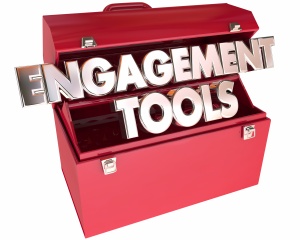 Yesterday, I posted a review of “Get The Job: Your Fundraising Career Empowerment Guide,” which is a book written by a very talented fundraising coach/consultant by the name of Mazarine Treyz. If the title of the book intrigues you, then you definitely want to check out my review. I suspect that after reading more, you’ll most likely be running off to Amazon to get yourself a copy.
Yesterday, I posted a review of “Get The Job: Your Fundraising Career Empowerment Guide,” which is a book written by a very talented fundraising coach/consultant by the name of Mazarine Treyz. If the title of the book intrigues you, then you definitely want to check out my review. I suspect that after reading more, you’ll most likely be running off to Amazon to get yourself a copy.
It should come as no surprise to anyone who knows Mazarine (or gets to know her through her books) that she used her book as a foundation to build an online virtual conference called the Fundraising Career Conference. This year the online conference is on a Monday, Wednesday and Friday starting on April 17th. There are 10 different sessions, and Mazarine has some very awesome presenters lined up. (If you are looking for CFRE credits, then you don’t want to miss this opportunity to earn some)
The training sessions are designed to deepen your knowledge on the topics presented in the book. The ultimate outcomes for participants include:
- Finding a new job
- Better understand your skills gaps
- Creating a better work environment for you and those around you
- Identifying and achieving your career goals
And if you’re afraid that someone also logging into the conference will see your name in an attendees box and tell your boss, then fear no more because Mazarine is keeping everyone’s identities hidden.
If you aren’t yet signed up for this online conference, I urge you to click-through and check it out. After all, it isn’t just for people currently looking for a job.
In order to give you a better feel for Mazarine and what her book and conference bring to the table, I “virtually” interviewed her. You can read the transcript in the space below. Enjoy!
 Q: What drives your passion to write a book and host an online conference to help people with their fundraising career aspirations?
Q: What drives your passion to write a book and host an online conference to help people with their fundraising career aspirations?
A: I have such a passion to help fundraisers because I feel like fundraisers are my tribe. I’ve moved on up from Development Associate, Development Assistant, Development Officer, to Development Director and now, finally, to Fundraising coach and conference organizer.
When i left my last fundraising job in 2009, I immediately began to write The Wild Woman’s Guide to Fundraising with everything I knew from the last 3 years of full time fundraising jobs in a one person shop. I wanted to pass on what I knew to people because so often in our fundraising jobs we just WING IT and we aren’t set up to succeed.
Now of course, after 8 years of teaching, I have so much more to teach that I’ve written 10 e-courses and a number of webinars about various aspects of fundraising in a LOT more detail than I went into in the book.
And during my time in full time fundraising, I had the experience of bosses that really did not know what they were doing. We had the issue of the MBA boss coming from the board in my last 2 fundraising jobs, which means they may understand business, but they don’t know fundraising.
So because of this experience, it makes me feel like we have to protect fundraisers from unrealistic expectations, and help them find out if there are going to be these unrealistic expectations RIGHT IN THE INTERVIEW. So what we teach at the Fundraising Career Conference is career self empowerment. Everything from how to negotiate your salary to how to build a better relationship with your boss.
But! We also have to teach bosses what fundraising is and how to manage us better. So that’s why in 2016 I created the Nonprofit Leadership Summit, so we could speak to both sides of the aisle.
It helps people learn how to fundraise more effectively but it ALSO drives home the cost saving message that if you TRULY want your nonprofit to be efficient and effective and raise BUCKETLOADS of money, you need to treat your staff well, and help them stay.
Q: What is the biggest challenge you see fundraising professionals grappling with regarding their career path and advancement opportunities?
A: I tend to see two types of challenges with people. One is people who are victims of gender bias as women. They tend to be underpaid, under-appreciated, and under-resourced in their fundraising jobs. So usually they have to move to another nonprofit to make any changes to their situation.
Sometimes women who are older, who feel like no one wants to hire them because they are older women come to me and ask me what to do. They get the double whammy of age bias and gender bias combined.
And then there’s people who have had bosses who don’t understand fundraising, which leads to a whole host of problems, including no money invested in fundraising databases, or events, or marketing, or insisting that the fundraiser be at their desk when they need to be out in the community meeting people. That’s why this year at the Fundraising Career Conference we’re going to talk about how to manage up at your fundraising job, and teach your boss why you do what you do, and how they can best support you.
Q: The average tenure for a fundraising professional is just a couple of years according to some studies. Why do you think the development director position is such a “revolving door?”
A: The revolving door is a result of a few things. According to Penelope Burk’s Donor Centered Leadership, AND the Underdeveloped Report by the Haas Jr Fund, people leave because:
- They do NOT have a good relationship with their boss. That’s why this year we’re going to teach how to deliberately build trust with your boss at the online Fundraising Career Conference in April 17-21, 2017.
- They can get a better salary elsewhere. And this is unfortunately how it goes, instead of negotiating in their current role, they jump ship and go somewhere else. But in this fundraising career conference we’ll be teaching people how to negotiate their salary at their current organization, as well as in a new job. But we’ll also talk about what else you can get, aside from salary, to help this be your dream job.
- I find that when people in fundraising are supervised at all, at least in small nonprofits, we aren’t encouraged to focus on our strengths, and we are given 3-5 people’s jobs to do, and we burn out. This does happen much more often than we like to admit, and so often we see it as a personal failing that we can’t do the work of 2-3 people. But it’s not a personal failing. It’s not your fault. This is what is known as a super job, when you have to do more than one person’s job for no extra pay. And lots of people have this problem, from hotel maids and pepsi truck drivers to nurses and doctors. So we need to work on our boundaries, and last year we went over that.
So in this 2017 Fundraising Career conference we’ll talk about how to manage up, use your strengths, and create space for deeper conversation instead of pretending the problem doesn’t exist.
Q: Do you have any advice for fundraising professionals who seek greater longevity and a sense of fulfillment in their current job?
A: Yes. I wrote a whole book about it, so answering this question feels like trying to fit an elephant down a plughole.
For greater longevity, read this interview with Kishshana Palmer about how to manage up in your fundraising role. This will help you be aware of what your boss does and doesn’t understand about fundraising, and hopefully help you start conversations that will make your workplace support you more.
Next, for greater longevity, you want to help your boss learn to trust you. Read this interview with Marc Pitman, as he talks about the signs that are there when there’s lack of trust, and gives you 13 tips on how to create trust with your boss.
Then, if you want a greater sense of fulfillment in your work, you need to check out the Gallup test, where they interviewed 3 million people, and found out that people have these strengths. Take the Strengthsfinder 2.0 test online. Once you find your 5 strengths based on that test, you’ll have a better idea of what you are good at in fundraising and what you should focus on. We’re always told to shore up our weaknesses, but in honesty we should focus on our strengths as much as we can, because this is where we get the juice to be a good fundraiser.
Of course, you can get the book, Get the Job, Your Fundraising Career Empowerment Guide, on my website, and you can definitely come and ask questions at the Fundraising Career Conference, because these two things together will help you get this.
Q: Most fundraising professionals need to become experts at “managing up” in their organizations. Do you have any tips or fun success stories on how to do so effectively?
A: Oh yes! First, you want to ask your boss, what’s your favorite communication style? And they might say, “Email” or “Texting” or “Phonecalls” so, you want to try to communicate with them most often in that manner. However, face time is still important. So,
Second, insist on meeting with your boss every week for 5 minutes on Monday. Go over your priorities for the week, explain why they are your priorities, and ask your boss if they have questions. Or, if your boss is setting your priorities, ask if there’s anything they would like you to do differently. This way you’ll be able to head off any miscommunication at the pass.
Third, if they expect you to do 2, 3, 4, or 5 people’s jobs, when you have this meeting, you can say, “OK you’ve given me 80 hours of work. Which 40 would you like me to do?” This is a way you can push back and have better boundaries at your job.
We are going to be covering how to manage up in a LOT more detail at the Fundraising Career Conference, with a session on how to do this with Kishshana Palmer. I’m really looking forward to this, people are going to learn so much! (Myself included)
Q: What is your favorite story you like to tell others about your book “Get The Job! Your Fundraising Career Empowerment Guide” (either in writing the book or anything associated with the book)
A: I like to tell people that the reason I wrote this book is because I GOT MAD.
I got mad when I saw good fundraisers raising a lot of money and being treated like garbage.
I looked at them being thrown out for systemic problems, not because they didn’t know what they were doing.
I was outraged when I witnessed people being fired for no reason other than their boss got a wild hair. This led me to research workplace bullying, and help people understand it.
It upset me when I saw bosses stealing large sums of money, and lying and cheating their staff out of the wages they were supposed to have from a government contract.
I heard about friends going to interview and being offered $10/hour and having the interviewer laugh and say “ha ha we all wish we could make more! You just have to believe in the mission!!” and that made me even more upset.
Probably the most egregious thing was when I talked with a government leader at the Portland Development Commission, who was in charge of facilitating better relations with the largest apparel and technology companies in our state (Nike, Adidas, Intel, etc).
I asked him, “Why don’t you focus on nonprofits?” And he said, “Because nonprofits bring the median income of a region down.”
And that, right there, is when I knew that I needed to agitate for worker rights, and for helping fundraisers and all nonprofit staff demand a higher salary, better working conditions, no super jobs, a pension and retirement fund, better healthcare, and just decent work.
Why should we be punished with bad wages, no real healthcare, and no way to retire, just because we wanted to make the world a better place?
HOW can nonprofits say they want to create a better world when they actively make it worse for their employees? It’s the height of hypocrisy.
I wrote my Get the Job book in 2013, but it wasn’t enough for me. I wrote a research report called Shafted in 2014, but that wasn’t enough either.
So in 2015 I started the online Fundraising Career Conference and in 2016 I started the online Nonprofit Leadership Summit, and it’s my goal to have as many people as possible take part in these events, so that we can start a larger conversation around decent work in this country. They’re already having the conversation in Toronto with the Ontario Nonprofit Network in Canada. We’re lagging behind here and we’ve got to get caught up.
Q: I see that this is the third year you’ve hosted the Fundraising Career Conference. What new and exciting things can participants look forward to this year?
A: Yes! I’m so psyched about this year because we’re going deeper into how to create a better relationship with your current or future boss.
Now, if you’re any good in fundraising at all, you will have been fired, because to be a good fundraiser you have to be able to say no. And so you probably have had a boss who, to put it mildly, has NOT been able to support you in the best way in your work.
Well, this year we’ll have a session from Marc Pitman about how to build trust with your boss, deliberately, which I’m looking forward to very much.
We’ll have a session with Pearl Waldorf, a therapist, who is going to be talking about how to create space for authentic communication at work, and how to assess your boss to see how to communicate with them.
We’ll have a session from Peter Drury all about how to be a better mentor and manager.
We’ll have a session from Kishshana Palmer on how to manage up,
And we’ll have a session for new consultants on how to be a better consultant, how to market your business starting out, and more.
There are so many good sessions that are new and exciting this year, it’s hard to not list them all. But these sessions are the ones that I think signify the integration theme of this year, where it’s not adversarial against your boss, and we’re not focused on healing. Rather, we’re focusing on how you are like your boss, and how your boss is like you. We’re encouraging people to step up and be leaders in their organizations, no matter what their titles are, and that, I think, is a true step towards self empowerment in your career.
Q: Unlike in-person conferences, the Fundraising Career Conference is online. What inspired you to develop and offer a virtual conference? And for those who have never participated in an online conference, what should they know and do you have any tips for them?
A: Here’s the deal. I’m a millennial. Millennials are lazy! That’s why you can attend this conference in your pajamas. Just kidding. Millennials have no money. Because we’re in late stage capitalism. And on top of that, many nonprofit people are underpaid. That is why you can attend this conference without having to go on an airplane and buy a taxi ride and eat crappy airport food and stuff like that. I wanted it to be available to anyone who wanted to go.
At an online conference, the nice thing is, you can sit at your desk at work (or in a coffeeshop somewhere) and attend this conference. Then you can go back to doing your work.
And if you have to miss some sessions, we’re recording everything for you, so you can go back and watch it later. And we have a phone number to listen in as well. So whether you choose to connect on the phone or on your computer, you’ll have a way to be involved. We also have a questions pane where people can enter questions during the sessions each day, so everyone will have a chance to have their questions answered.
This is one of my favorite things, being able to answer questions during and after each session, and pass questions on to the presenters, who have also graciously volunteered to answer questions after the conference is over.
 Learn more about Mazarine Treyz
Learn more about Mazarine Treyz
If you can’t tell, I’ve quickly become a fan of Mazarine Treyz. She is one of the more genuine people who I’ve met in my travels, and I’ve quickly become a fan. Like me, Mazarine is a blogger and you can learn a lot about her by visiting her blog and sifting through her posts. You can find her at Wild Woman Fundraising. But if you do nothing else, you should go buy a copy of this book. I promise that you won’t regret it!
 This is part three in a five part series that I started last week with two posts titled:
This is part three in a five part series that I started last week with two posts titled:
 It is a common occurrence in my life for a non-profit organization to call and want
It is a common occurrence in my life for a non-profit organization to call and want  Two days ago, I published a post titled “
Two days ago, I published a post titled “ Donors want to know how those you serve are being impacted by the changing world around us. So, help them see it.
Donors want to know how those you serve are being impacted by the changing world around us. So, help them see it. Yesterday, I published a post titled “
Yesterday, I published a post titled “ Take a good look up and down this list. It is way to easy to buy into an explanation like “My-Liberal-Friends-Are-Rallying-The-Troops” phenomenon.” Right? And I almost did, but Jiminy Cricket was still wagging his finger at me (or maybe it was Trump). So, I held off on publishing my Trump blog post for a little longer.
Take a good look up and down this list. It is way to easy to buy into an explanation like “My-Liberal-Friends-Are-Rallying-The-Troops” phenomenon.” Right? And I almost did, but Jiminy Cricket was still wagging his finger at me (or maybe it was Trump). So, I held off on publishing my Trump blog post for a little longer. “Trump is like having a golden ticket’ to Willy Wonka’s Chocolate Factory for those organizations who know how to fundraise. But those organizations who have been fat and sassy and accepting lots of government funding instead of fundraising are likely going to fail or merge with other organizations.”
“Trump is like having a golden ticket’ to Willy Wonka’s Chocolate Factory for those organizations who know how to fundraise. But those organizations who have been fat and sassy and accepting lots of government funding instead of fundraising are likely going to fail or merge with other organizations.” Lots has been said about President Trump and how his administration will impact the non-profit sector. The thing that strikes me as funny is that if you go back to those speculative news articles and online stories that started popping up in November and follow them through to current day, everyone seems to be right and at the same time wrong.
Lots has been said about President Trump and how his administration will impact the non-profit sector. The thing that strikes me as funny is that if you go back to those speculative news articles and online stories that started popping up in November and follow them through to current day, everyone seems to be right and at the same time wrong. I think the reason why I have struggled with writing this blog post for so long about non-profits and Trump is because I felt compelled to write about how the next four years were going to be a disaster (and there is a compelling argument to be made) BUT my non-profit soul was conflicted and screaming:
I think the reason why I have struggled with writing this blog post for so long about non-profits and Trump is because I felt compelled to write about how the next four years were going to be a disaster (and there is a compelling argument to be made) BUT my non-profit soul was conflicted and screaming:
 Learn more about Mazarine Treyz
Learn more about Mazarine Treyz
 Q: What drives your passion to write a book and host an online conference to help people with their fundraising career aspirations?
Q: What drives your passion to write a book and host an online conference to help people with their fundraising career aspirations?